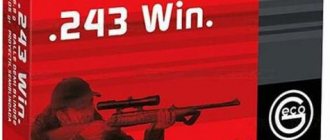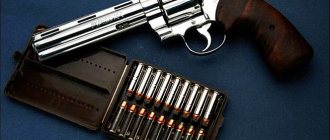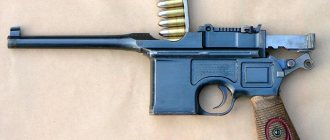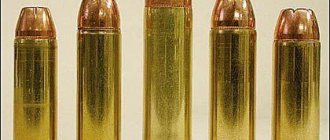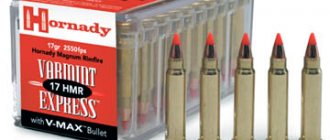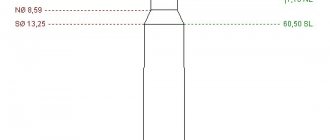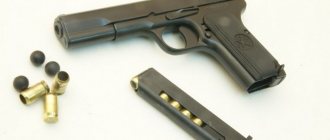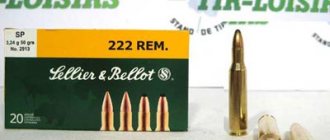Cartridge 5.6×50 R Magnum
| 5.6×50R Magnum |
The 5.6x50 R Magnum cartridge is designated: 5.6x50R Magnum / 5.6x50 R Mag / 5x50 R / DWM 647 / SAA 0740 / XCR 06 050 BBC 020.
The European high-speed cartridge 5.6×50 R Magnum (not to be confused with 5.6×50 Magnum) was created in 1968 by the German company RWS, for shooting roe deer and for use in combined weapons of a turning point design, traditional for Western European countries.
5.6×50 R Magnum
With a bullet weight of 3.56 g, the initial speed of the 5.6×50 R Magnum cartridge is about 1000 m/s. Hunters did not show noticeable interest in the wafer version of this cartridge (5.6×50 Magnum), intended for bolt-action repeating rifles. The ballistics of the 5.6×50 R Mag are naturally slightly lower than those of the wafer version of the 5.6×50 Mag. The use of European cartridges for hunting is subject to approximately the same restrictions on the maximum weight of game as most American .22 caliber ammunition.
The 5.6×50 R Magnum cartridge has a bottle-shaped case with a flange, a small-diameter capsule of the Small Rifle type, a maximum bullet diameter of 5.70 mm (.224″), maximum case and cartridge lengths of 50.00 mm and 61.00 mm, respectively, average powder gas pressure according to the CIP standard, measured by the piezoelectric method - 3000 bar, maximum 3400 bar (340 MPa or 55100 psi).
It is equipped with expansive semi-jacketed bullets of the TMS type and non-expansive bullets of the VMS type. 5.6×50 R Magnum
The optimal zeroing distances for this cartridge with bullets weighing from 3.24 g to 4.1 g are in the range from 175 to 210 m, while the bullet deviates from the aiming line no more than: at a distance of 50 m - +1.0 cm, 100 m - +4.0 cm, 150 m - +4.0 cm, 200 m -4.1 cm, 300 m - -46.0 cm.
The production of factory ammunition was established by the Austrian company Hirtenberger and the German RWS (Dynamit Nobel), while the caliber of ammunition provides a wide selection of bullets for independent equipment.
In Europe, quite a lot of weapons were chambered for the 5.6×50 R Magnum cartridge: these are rifles and carbines from Mauser, Steyr - Mannlicher, Kriko, Heym, Tikka and others.
Like most other 5.6 mm cartridges with high muzzle velocities, the 5.6x50 R Magnum can be used for shooting medium-sized animals, i.e. in the range of 10-50 kg. Shows very good results when shooting animals such as roe deer, saiga, wolf and others. The excellent flatness of the combat (flat trajectory of the bullet) allows this cartridge to be used with a 4-gram bullet and for mountain hunting. The killing power of this lightweight bullet is also quite sufficient for chamois and mouflons at distances of up to 200 m.
| 5.6×50R Magnum |
Cartridge 6.5×50 mm SR Arisaka
6.5x50 mm SR Arisaka (see also Other designations) is a cartridge adopted by the Imperial Japanese Army in 1897 along with the Arisaka repeating rifle (Type 30). Developed by Major Murata, although both the rifle and the cartridge are better known by the name of the head of the small arms development department of the Tokyo Arsenal, Colonel Arisaka. The new cartridge replaced the 8 mm Murata cartridge adopted ten years earlier with a bullet weighing 15.2 g in a copper jacket and with a charge of black powder in a brass flanged sleeve.
Cartridge 6.5x50 mm SR Arisaka. All dimensions are in millimeters.
| CARTRIDGE WEIGHT, g | BULLET WEIGHT, g | BULLET SPEED, m/s | BULLET ENERGY, J |
| 21,1–25,8 | 9,0–13,3 | 730–770 | 2615± |
Unlike its predecessor, the 6.5 mm cartridge was loaded with a charge of smokeless nitrocellulose flake powder weighing 2.04 g. Early cartridges had a blunt-pointed bullet weighing 10.4 g and a muzzle velocity of 730 m/s. Later cartridges (in accordance with design changes to cartridges in other countries) had a pointed bullet weighing 9 g with a powder weight of 2.5 g and a muzzle velocity of 770 m/s. The charge was placed in a 50.7 mm long brass bottle sleeve with a so-called semi-protruding flange (English Semi-Rimmed, hence the abbreviation SR in the name of the cartridge). That is, the diameter of the flange at the bottom of the sleeve exceeded the diameter of the body by less than 0.8 mm. Above the flange on the case body there was a shallow groove for a more reliable engagement of the ejector. This made it possible to use the main advantage of the cartridge case with a protruding flange - fixation of the cartridge case in the chamber along the breech section of the barrel, which allowed the manufacture of the cartridge and chamber with rougher tolerances. At the same time, the slight protrusion of the flange did not make it difficult to place cartridges in the magazine and chamber them. The capsule socket of the sleeve had a central anvil and two seed holes. The Berdan type brass capsule usually had a convex surface. Occasionally he made two radial strokes.
Cartridge 6.5x50 mm SR Arisaka with a blunt bullet.
The characteristics of the pointed cartridge remained unchanged until 1922, when the Type 11 light machine gun was adopted. This machine gun initially used standard five-round infantry rifle clips with blunt bullets. Accordingly, when using new cartridges, it turned out that they lead to rapid wear of parts and breakdowns of the machine gun, since new cartridges develop higher pressure in the barrel, which ultimately affects the operation of the automation. This problem was solved by the release of a special series of cartridges with a reduced amount of gunpowder. On the packaging of these cartridges there was a special stamp with the Latin letter “G” (Genso (Japanese: 減少) - reduced, depleted). Such cartridges were also issued to soldiers with the Type 96 light machine gun and to snipers with the Type 97 rifle. The advantage of using these cartridges for snipers was lower recoil (which was less tiring for the shooter) and a weak muzzle flash when fired (which made it difficult to detect the sniper when firing).
There were also cartridges with wooden or paper bullets, and training (brass or wood with a red lacquer coating and a metal bottom) dummy cartridges were produced. The cartridges used when firing from a rifle grenade launcher had paper bullets and can be identified by the reinforced fastening of the primers (so that they do not fly out of the cartridge case under increased pressure in the barrel).
After becoming familiar with the cartridge during the Russo-Japanese War in 1905-1906, leading Russian gunsmiths designed self-loading rifles chambered for this cartridge. The standard Russian cartridge at the time, 7.62x54 mm R, was too powerful and gave strong recoil in automatic weapons, so the Japanese one could not have been more suitable for these purposes.
Early designs of Vladimir Fedorov's automatic rifles, such as the Fedorov Avtomat, used this particular cartridge.
During the First World War, due to a shortage of weapons, the tsarist government purchased Arisaka carbines of the 1905 model, which were used on the Caucasian front. In addition to rifles, orders were placed for the supply of cartridges for them: 660 million Japanese 6.5-mm rifle cartridges were ordered with funds from the English loan, and another 124 million cartridges were ordered with funds from the Japanese loan.
In 1915–1916, the 6.5 mm Japanese-style cartridge was manufactured at the St. Petersburg Cartridge Plant in Russia with a circulation of up to 200 thousand pieces monthly. Externally, they differ slightly in the shape of the primer and the bottom of the sleeve.
In 1914, approximately 150,000 Arisaka Model 1897 rifles and carbines were sold to the UK, mainly to the Royal Navy, where they were used for training personnel.
Cartridges 6.5x50 mm SR Arisaka made in Japan.
The 6.5x50 mm Arisaka cartridge was officially adopted into service in 1917 as the .256 caliber Mk. II and later were produced. It is believed that the Arab forces led by Lawrence of Arabia during World War I against Turkey had Arisaka Model 1897 rifles, although it has been suggested that the Bedouins used captured Turkish Mausers.
During the Russian Civil War, the Arisakis of the British Navy were transferred to the White Guards.
The Russians, having a stock of Arisaka rifles of the 1897 and 1905 models (captured during the Russo-Japanese War, as well as through purchases during the First World War), stored a number of them in Finland. During the revolution of 1917, the warehouses were captured and the rifles entered service with Finnish troops.
The rifles were used by the Finnish cavalry and, after the separation of Finland from Russia, attempts were made to change the caliber of the rifles to 7.92x57 mm. The Finnish government also transferred rifles to the reserve forces and merchant fleet, and later resold the rifles to Estonia. Finnish "Arisaki" have district numbers and the letter "S" on the stock.
The cartridge also has the following designations:
- 6.5 x 51 R Arisaka Semi-Pestaña
- 6.5×51 SR Arisaka
- 6.5 Arisaka Tipo 1 – Tipo 2 – Tipo 30 – Tipo 38
- GR 830
- DWM 481
- DWM 481A
- ECRA-ECDV 07 051 BDC 010 (type 30)
- ECRA-ECDV 07 051 BDC 015 (type 38)
Weapons using cartridge
- Rifles and carbines of the Arisaka system
- Machine guns Type 3, Type 92
- Type 11 machine gun
- Machine guns Type 96, Type 99
